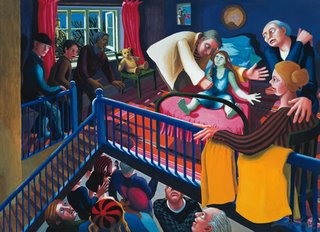
And when he had entered, he said to them, “Why are you making a commotion and weeping? The child is not dead but sleeping.”
And they laughed at him. But he put them all outside and took the child's father and mother and those who were with him and went in where the child was.
Taking her by the hand he said to her, “Talitha cumi,” which means, “Little girl, I say to you, arise.”
And immediately the girl got up and began walking (for she was twelve years of age), and they were immediately overcome with amazement.
And he strictly charged them that no one should know this, and told them to give her something to eat.
* * *
There are many things we can learn from this beautiful story. Jesus went to the house of Jairus (Luke gives us the man’s name) during a time of mourning. Lesson: “weep with those who weep” (Romans 12.15).
The crowd laughed at Jesus — the crowd still laughs at him — but this did not, does not deter him from the business of turning death into life. Lesson: Do not be deterred from doing good by the scorn of others.
Christ immediately raised the girl from the dead. Lesson: We can comfort in knowing that Jesus is stronger than death, that in fact he raised himself from the grave as he promised when he said, “Destroy this temple, and in three days I will raise it up” (John 2.19).
Notice, however, the understated closing to the story: he “told them to give her something to eat.” Jesus had already gone further than anyone else could have — he performed a miracle — but now he goes even further, a third mile. His concern for this little girl existed not only at the great life-or-death level, but also at a more mundane and very human level: Is she hungry?
Food was an integral part of Christ’s ministry and I believe this is a neglected theme of the gospels. He fed five thousand famished men on one occasion, four thousand on another (“I do not want to send them away hungry,” he had said in Matthew 15.32, “for they might faint on the way”). He once allowed his hungry disciples to pick grain to eat on a Sabbath and defended them from the accusations of the Pharisees afterward. After his resurrection, he even cooked breakfast for Peter and some of the other disciples.
Moreover, he was always accepting invitations to eat — and using such occasions as opportunities to teach. It is almost startling to note just how often Jesus was found eating with people: at the home of Simon the Pharisee (Luke 7); at the home of Mary and Martha (Luke 10); at the home of a prominent Pharisee (Luke 14); at the home of Simon the Leper (Mark 14); with his disciples the night of his betrayal (Luke 22); with two disciples he met on the Emmaus Road (Luke 24). In fact, food was such a central feature of his ministry that he was unfairly accused of being a glutton. (Luke 7.34)
Sometimes we seem to think that we can win people to the Lord simply by overwhelming them with doctrinal soundness. But this was not Christ’s method: He supplied them with loaves and fishes, in addition to doctrinal soundness. It has been said that people don’t care how much we know until they know how much we care. There are few better places to show how much we care than around a dinner table.
(Painting by Dinah Roe Kendall)



